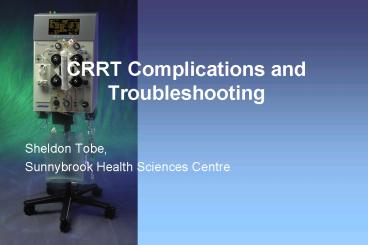CRRT Complications and Troubleshooting - PowerPoint PPT Presentation
1 / 24
Title:
CRRT Complications and Troubleshooting
Description:
At the end of this presentation, the health care provider will be able to: ... be black in color (the use of black caps is restricted to this drug product only) ... – PowerPoint PPT presentation
Number of Views:1969
Avg rating:3.0/5.0
Title: CRRT Complications and Troubleshooting
1
CRRT Complications and Troubleshooting
- Sheldon Tobe,
- Sunnybrook Health Sciences Centre
2
Objectives
- At the end of this presentation, the health care
provider will be able to - List the potential errors associated with
pharmacy prepared solutions - Review actual errors associated with CRRT
solutions that have occurred in different
institutions - Apply the information to a case study
3
CAN YOU IDENTIFY POTENTIAL FOR ERROR?
4
Potential for Errors in CRRT
- Physician errors when using non standard orders
for dialysate or replacement solutions - Nursing administration errors in choice of
solutions - Pharmacy transcription errors in dialysate orders
- Pharmacy calculation errors in compounding
- Pharmacy product selection errors in compounding
5
NEED FOR STANDARD ORDERS
6
Administration Errors
- Confusion of calcium chloride infusion bags for
sodium bicarbonate replacement solution bags - Labeling of calcium chloride infusion bags with
bright fluorescent stickers by pharmacy - Separation of replacement fluids from calcium
chloride bags in separate bins
7
Administration Errors
- Nursing mixed concentrated Normocarb dialysate
with normal saline instead of sterile water - Pharmacy mixing of Normocarb?
8
(No Transcript)
9
Dialysate Compounding Errors
- Foothills Medical Centre, Calgary Health Region
- 83 yo female in CV ICU died suddenly in the
presence of family and physicians - ICU physician suspected dialysate used for CRRT
- An analysis of dialysate solutions revealed
potassium chloride was used in place of sodium
chloride - Attributed to another death that occurred one
week prior
10
Foothills Medical Centre, CHR
- 3 liter bags prepared in batches of 36 bags
- Dialysate concn Na 110 mEq/L, Mg 0.7 mEq/L
- Prepared by 4 pharmacy technicians involved in
setup and documentation, checking of setup,
product transfer, final check - No empty bottle verification against worksheet
- No pharmacist check of final product
11
Foothills Medical Centre, CHR
- At FMC, 34 of the pharmacy staff were
pharmacists - National averages are 44 pharmacists
- Tech check tech delegation endorsed by CSHP
- Over delegation of pharmacist responsibilities?
12
CHR Recommendations
- The feasibility of using commercially prepared
dialysate solutions be explored. - When patient care issues necessitate that
in-house manufacturing of complex preparations be
undertaken, process mapping be used to simplify
the processes as much as possible.
13
FDA Labeling Changes
- Death due to the accidental misadministration of
concentrated KCl Injection led to - Changing the official USP name to Potassium
Chloride for Injection Concentrate (emphasis
added) - Labels must now bear a boxed warning
"Concentrate Must be Diluted Before Use" - The cap must be black in color (the use of black
caps is restricted to this drug product only) - The cap must be imprinted in a contrasting color
with the words, "Must be Diluted."
14
Different Perspectives
- According to ISMP survey, 91 nurses vs 98
pharmacists consider IV KCL to be a high alert
medication - 73 nurses vs 94 pharmacists consider hypertonic
sodium chloride inj to be a high alert medication
15
Time Requirements
- Pharmacy needs advanced notice to prepare
dialysate, replacement fluids, calcium chloride,
citrate infusions - Often the same patient requires pressors that
need to be mixed by pharmacy - Daily rounding and ordering of solutions by ICU
pharmacist to determine need
16
USP 797
- Immediate Use Exemption from ISO Class 5 (Class
100) - Three or fewer sterile products may be prepared
in worse than ISO Class 5 air when there is no
direct contact contamination, and administration
begins within 1 hour and is completed within 12
hours of preparation.
17
USP 797
- Need for aseptic preparation?
- IHD data on bicarbonate dialysate
- Bacterial growth and endotoxin production
- Sterile versus non sterile dialysate
- IL 1 production
- Interleukin hypothesis
18
Water and Dialysate Quality
19
Case Study
- What happened?
- Analysis of the replacement fluid revealed that
the NaHCO3 was never placed in the solution and
the total Na was 105 mEq/L
20
Case Study
- Root Cause Analysis
- Why was sodium bicarbonate not added to the
solution? - Are the replacement solutions prepared in batches
or on a patient by patient basis? - What is the process for pharmacy set-up,
preparation, final check and documentation? - Are the products and syringes made available for
final check? - Is the pharmacist involved in checking the final
product?
21
Extemporaneous Compounded Solutions
mEq/L unless otherwise stated
22
Comparison of Commercial Dialysate
23
(No Transcript)
24
Recommendations
- Use commercially available products whenever
feasible - Standard physicians orders for CRRT solutions
- Separate look alike drugs in the pharmacy
- Ensure process for pharmacy prepared solutions is
mapped out - Ensure pharmacist is the final check!
- Training, training, training!
- Label and separate solutions at the bedside in
appropriate bins































